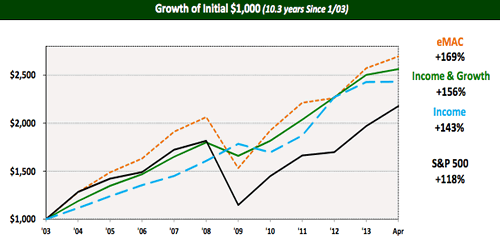Here is a check-in on the trailing 10-year total returns for the David Swensen model portfolio, courtesy of ETFPM.com. Last update was in 2011. As a reminder, here is the model portfolio asset allocation with representative ETFs:
30% Domestic US Equity (VTI)
15% Foreign Developed Equity (VEA)
10% Emerging Markets (VWO)
15% Real Estate (VNQ)
15% U.S. Treasury Bonds (IEF)
15% Inflation-Protected Securities (TIP)
The chart below shows the growth of $1,000 invested this way and rebalanced annually (eMAC), starting from January 2003 until the end of March 2013. eMAC stands for “efficent multi-asset class”.

Again, we see that this low-cost, diversified index fund portfolio (+169%) has done well over the last 10.3 years, besting the S&P 500 (+118%) handily as well as the Dow Jones Credit Suisse Hedge Fund Index (not shown anymore, but +95% roughly). We also see that a 30% Stock, 70% Long-term Treasury bond portfolio does pretty well, but I tend to dismiss that as rearview-mirror investing. Yes, looking backward it did well, but I doubt you could find any portfolio manager telling their clients to hold 30% Stocks and 70% Long-Term Treasuries as a long-term portfolio during the period between 2003-2007.
 The Best Credit Card Bonus Offers – 2025
The Best Credit Card Bonus Offers – 2025 Big List of Free Stocks from Brokerage Apps
Big List of Free Stocks from Brokerage Apps Best Interest Rates on Cash - 2025
Best Interest Rates on Cash - 2025 Free Credit Scores x 3 + Free Credit Monitoring
Free Credit Scores x 3 + Free Credit Monitoring Best No Fee 0% APR Balance Transfer Offers
Best No Fee 0% APR Balance Transfer Offers Little-Known Cellular Data Plans That Can Save Big Money
Little-Known Cellular Data Plans That Can Save Big Money How To Haggle Your Cable or Direct TV Bill
How To Haggle Your Cable or Direct TV Bill Big List of Free Consumer Data Reports (Credit, Rent, Work)
Big List of Free Consumer Data Reports (Credit, Rent, Work)
My portfolio over almost the same period is actually pretty darn similar to this (basically Total Bond Market in place of the Treasury Bonds and a little less REIT), so I’m happy to see it fared so well.